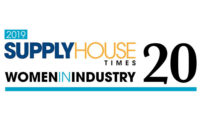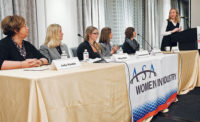Women in PHCP-PVF industry roundtable panel features female business perspective
Tackling the hard questions in the plumbing industry.

From left: Women in Industry Roundtable Panelists Christy Christy Maloney, Micaela McDonald, Janelle Grim and Mary Burke at the Meritage Resort and Spa in Napa, Calif. Photo by Timothy Shonnard (www.timothyshonnard.com).

Supply House Times Chief Editor Mike Miazga conducted an exclusive roundtable interview with ASA Women in Industry Division members, from left: Mary Burke (Burke Agency Inc.), Micaela McDonald (The Collins Companies), Janelle Grim (Fluidmaster) and Christy Maloney (Coburn Supply) during ASA’s Winter Leadership Meeting in Napa, Calif. Photo by Mike Miazga/Supply House Times

Coburn’s Maloney paints an extremely strong case for a woman considering a career in the PHCP-PVF industry. “I just read distribution as of 2015 in this country accounted for $7 trillion in sales, had 500,000 companies and six million employees,” she says. Photo by Mike Miazga/Supply House Times

The Collins Companies’ McDonald says gender shouldn’t matter in the workplace. “If you are offering solutions to their problems, that’s all you need to do. If you are helping them, they won’t care who you are,” she says. Photo by Mike Miazga/Supply House Times

Fluidmaster’s Grim says the Women in Industry Division is a critical component of ASA’s offerings. “There are great networking opportunities where you have the ability to meet women from different levels of the industry and learn that they are experiencing the same issues you are,” she says. Photo by Mike Miazga/Supply House Times





The American Supply Association’s Women in Industry Division is one of the PHCP-PVF national association’s many positive accomplishments in recent years.
Now in its fourth year of existence, Women in Industry has grown from an inaugural roster of 80 to one that now has nearly quadrupled in size to 306 members throughout the supply chain. The group will hold its fourth annual meeting in late April in Austin, Texas.
In early February, Supply House Times conducted an exclusive Women in Industry roundtable interview during ASA’s 2017 Winter Planning Meeting at the Meritage Resort and Spa in Napa, Calif. The hour-long discussion was punctuated by topics such as challenges women face in the industry, how to go about attracting more women into the PHCP-PVF space and the benefits of being part of the Women in Industry Division.
Participating on the roundtable panel were:
-
Janelle Grim, Regional Sales Manager-Central, Fluidmaster, San Juan Capistrano, Calif.;
-
Mary Burke, Chief Financial Officer, Burke Agency Inc., Walled Lake, Mich.;
-
Christy Maloney, Director of Finance and Strategic Planning, Coburn Supply Co., Beaumont, Texas; and
-
Micaela McDonald, Director of Human Resources, The Collins Companies, East Windsor, Conn.
Question: Historically why has there not been a lot of women in the industry?
This question was touched on numerous times throughout the interview, but kept coming back to essentially the same answer. “I don’t think it has been on women’s radar as a career path,” said Maloney, who worked in commercial banking prior to joining the fourth-generation family business. “There are a lot of things you have to study in industrial distribution such as engineering and logistics that can be quite intimidating. When I was in college I thought of entering the curriculum of production and procurement, but back then women weren’t getting into it. It used to be women got a degree in finance, accounting or became a school teacher or lawyer. I wish I would have gone into industrial distribution right away.”
Grim remains challenged by the lack of women in the industry. “I don’t understand it,” she said. “I’ve worked for several companies where I was the only female in outside sales. I manage 13 rep agencies and less than 1% of their outside salesforce is women. It’s kind of shocking when you look at it. I don’t believe it is sales in general, so it must be the plumbing industry. This is an awesome industry, however I struggle with how do we get more women into it.”
On the flip side, McDonald, Burke and Maloney did bring up success stories of women in their respective companies. “Our women are key producers to our organization on every level,” McDonald said. “From marketing to accounting to sales and purchasing they have proven that gender has no bearing on success. Their strong work ethic has helped us to become the profitable company we are today.”
Maloney added: “We have a woman in inventory control that is responsible for millions of dollars.”
Question: How can the industry attract more women into positions throughout the supply chain?
Maloney immediately suggested internships as well as recruiting female military veterans as two solutions to a concern in the industry that encompasses not only women, but men as well — finding new talent.
“Have these women come in and see how it’s done,” she said. “With the veterans, they have a great work ethic, discipline and embrace teamwork. That’s an area that hasn’t been tapped into.”
Panelists said educating women on the benefits of the industry is a must. “There are so many different roles in companies and different segments of the industry whether it’s in manufacturing, distribution or being a manufacturers rep,” Grim said. “This industry offers a lot of choices and flexibility.”
The panel also spoke of the quality work-life balance the industry provides. “Immediate access to technology today has helped to change this field dramatically,” McDonald said. “In many positions, you no longer need to be onsite as long as you have access to a smartphone or computer. This has allowed me to take the time needed to be with my family but jump back on if something needs to be handled.”
Maloney added: “I was just sitting in the bistro (at the hotel) loading up financial statements and posting them for January. Another thing is if a woman goes on maternity leave, they can take a laptop home with them. They have that important time with their baby, but if you know they have a good work ethic, they are going to get the work done.”
Burke had a suggestion for the industry. Look at the United States’ population data. “If you cut it down the middle, half the workforce is women,” she said. “If you are not looking at that half, what opportunities are passing you by?”
Question: Is there still the stereotype of women predominantly working in the bath and kitchen showroom segment of the industry?
The consensus here was yes, but with the caveat that things are changing in that regard. “You do see females in showroom sales positions,” Grim said. “They are valuable, so how do we move them to outside the showroom’s non-decorative product sales?”
Burke offered an interesting take on how women are entering the industry in general. “In smaller family-owned firms, of which there are many, it may be a family member or friend that has extended the invitation to a particular woman or women to join the business,” she said. “At the other end of the spectrum, as distributors consolidate and manufacturers grow, they tend to have human-resource departments that specialize in recruiting. They tend to cast a net across a broader spectrum of candidates, including many more women who may or may not have a traditional industry background.”
Burke added that regardless of how women enter the organization, the challenge is engaging and retaining them.
“This is where the ASA’s Women in Industry Division provides a critical role,” she said. “It is a network of highly competent professional women from each segment of the industry and includes just about every job title and level. The relationships made through Women in Industry provide an additional layer of support for learning, problem-solving and confidence building. It also adds an element of fun, which is so important.”
Question: What other challenges do women face in the industry?
“As a female salesperson, I’m around a lot of men and occasionally it feels like I’m being treated differently because I’m a woman,” Grim candidly stated. “That’s a tough question. You want people to respect you for your capabilities, but you don’t want to be treated differently. I enjoy this industry and the relationships built, but there are days when I say, ‘I’m just one of the guys.’”
However, the panel said such a challenge should be able to be quickly overcome. “Just take care of your customers. Know what you are doing and be responsive” was the advice Grim gave.
McDonald added: “If you are offering solutions to their problems, that’s all you need to do. It’s all you need to communicate. If you are helping them, they won’t care who you are.”
Burke circled back to the education aspect. “Do your homework and be technically astute,” she said. “It’s a challenge, but it’s a challenge no matter what type of industry you are in. You have to know what you are doing and you have to keep up on the latest technology, which is one of the biggest challenges for salespeople in general.”
And Burke added two pairs of succinct advice. “Respect is something where if you give it, you will get it back.”
And this gem. “What’s the old adage? People don’t care how much you know until they know how much you care!”
Question: What has ASA’s Women in Industry group meant to you personally and professionally?
Just like the annual question posed during the ASA-Supply House Times distributor roundtable at the NETWORK gatherings about the overall benefits of ASA membership, panelists here raved about the benefits of the Women in Industry Division.
“It’s critical,” Grim said. “It’s been going for four years now and I’ve been in it since its inception. There are great networking opportunities where you have the ability to meet women from different levels of the industry and learn that they are experiencing the same issues you are. It’s not much different than what the millennials experience with the Young Executives Division. Women in Industry’s annual conferences offer quality speakers, networking opportunities and beneficial educational seminars. I encourage all women to attend our next one in Texas in April.”
McDonald added: “Every year I make new friends. This division has been essential to my network and growth throughout the industry. You share best practices, different outlooks and gain a greater understanding of the industry as a whole by getting involved.”
Burke, who touched on her feelings about the division earlier, is ready to welcome more members. “We started small and are gaining such great momentum,” she said. “We look forward to continuing to share this enthusiasm with others as we invite them in and show them the way, including all the great things this industry has to offer.”
The final question of the interview centered on what would the panelists’ pitch be to a young woman about the PHCP-PVF industry?
Maloney, with her financial background, used her statistical prowess to close things out.
“I just read distribution as of 2015 in this country accounted for $7 trillion in sales, had 500,000 companies and six million employees,” she said. “That’s a pretty impressive industry to work in.”
This article was originally titled “Tackling the hard questions” in the March 2017 print edition of Supply House Times.
Looking for a reprint of this article?
From high-res PDFs to custom plaques, order your copy today!











